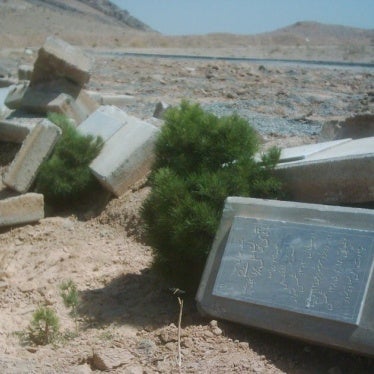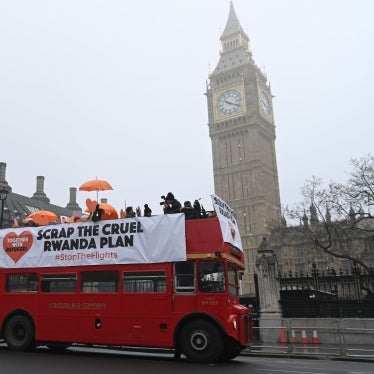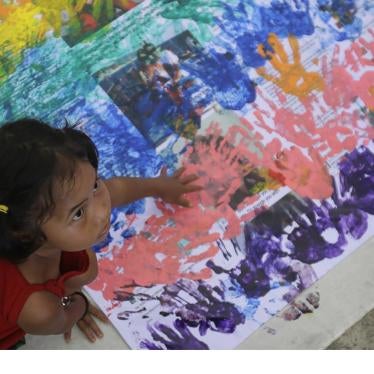(New York) – The Syrian government should immediately grant United Nations observers full access to Homs and Aleppo central prisons to check on prisoners who may be at risk of violent reprisals following prison riots, Human Rights Watch said today.
“Samir,” an inmate in the old section of the Homs central prison, told Human Rights Watch by phone that a riot broke out on July 21, 2012, and that prisoners took over parts of the prison. In response, he said, government forces surrounded the facility, used live rounds and teargas to attack the prisoners, and cut off food and water supplies. Samir reported at least seven deaths, including three children, and an activist reported at least three more.
The Syrian National Council, a coalition of opposition members, in a statement on July 24, said that government forces used live fire and teargas at Aleppo central prison in response to prisoner protests on July 23 and that eight people had been killed. Human Rights Watch has not been able to contact anyone in Aleppo central prison.
“The uncertainty surrounding the fate of inmates in Homs and Aleppo shows the urgent need for UN monitors to get inside these prisons and publicly report on their findings,” said Sarah Leah Whitson, Middle East director at Human Rights Watch. “The Syrian government should be on notice that the international community is watching, and that any violent crackdown in prisons will not go unpunished.”
Samir said the riot in Homs central prison began around midnight or 1 a.m. on July 21:
The prisoners asked General Khaled Ahmad Kakhi for permission to pray in the fields for Taraweeh prayers [night prayers conducted during Ramadan, often communally] but he refused. The prisoners were very frustrated and it was not possible for us to pray inside the prison cell because the cells are overcrowded. There are around 15 men in a prison cell that barely fits five. We can’t sit or sleep– how we can pray. The prisoners started yelling and soon we started to say Allahu Akbar. This was happening in the old building where I am. After a few minutes the whole section, which is adjacent to the section where those on drug charges are held, started to say Allahu Akbar. The prisoners, including me, started breaking the windows and the radiators in the cell. The radiators are very old and it was very easy to pull them off the walls. We used the radiators to take down one wall, which links us to the drug section...
In a matter of hours the prisoners were able to break out of their cells by breaking doors, windows, and walls. The reaction of the security forces in the old building was to run away. They didn’t even try to stop us. On my floor there were four or five officers who were very scared and they left. We were able to take control of the old building and when we did, around 5 a.m., the security forces started throwing tear gas through the windows. Some men went to the roof to breathe. Ali al-`Akaydi, one of them, was shot and died instantly. He was the first one to die…Jandal Rajoub was also shot in the head [and killed] while standing on the rooftop.
After that they started firing live bullets at the windows…The security forces stationed outside the central prison and snipers stationed at the water container, which is around 20 meters high and located in the middle of the prison, were shooting toward the rooftop, and the snipers were also throwing tear gas canisters.
An activist with the Syrian Revolution General Committee who is a member of the Syrian Human Rights Network told Human Rights Watch that he was in contact with six people inside the Homs central prison who were updating him on the situation. He said that rioting prisoners were assisted by armed officers who had defected and then clashed with the Syrian security forces. In addition to the death of al-Akaydi, he reported the deaths on July 21 of Mahmoud Hassoun, Mahmoud Turkmen, and Ahmed Jammu. Human Rights Watch cannot independently confirm the deaths or the defections.
Samir told Human Rights Watch that the situation inside the prison escalated on July 22. He told Human Rights Watch that the riots spread to the new section of the prison housing children and female detainees:
In the new building they couldn’t tear down the walls but they were able to break the locks of the prison cell. I don’t know how they were able to do it. It could be that the officers let them out before evacuating the building on purpose. In the new building there is the women’s, children’s, and security section. The security section is where the political activists have been locked for years.
Samir told Human Rights Watch that two other inmates– Ahmad Herman and Jamal Sahyouni– were killed on July 22 as well as three children who died from suffocation from teargas. He said that 16 prisoners had been wounded and that prison authorities “didn’t agree to let the Red Crescent in to provide medical care for the wounded.”
Samir said the humanitarian situation in the prison was dire. He said the government stopped supplying food to the prison after the riot broke out on July 21, and on July 23 the government cut off electricity and water. He explained that the prisoners had been living off of leftovers, which were gone by July 25, and that they “will start making bread from the flour we found. We are burning wood to bake the bread because there is no electricity to turn the stove on.”
During its news bulletin on July 25, Syrian state media indicated that “calm had returned to Homs central prison after the situation was handled with dialogue.” Human Rights Watch has been unable to reach Samir to get an update since late afternoon on July 25.
Human Rights Watch called on the Syrian government to give the United Nations Supervision Mission in Syria (UNSMIS) full access to detention facilities, including Homs and Aleppo central prisons, to monitor abuses.
Human Rights Watch also reiterated its call to the UN Security Council to refer Syria to the International Criminal Court (ICC) and urged other countries to join the calls for accountability by supporting a referral to the ICC as the forum most capable of effectively investigating and prosecuting those bearing the greatest responsibility for abuses in Syria. Human Rights Watch has called on the UN Security Council to impose an arms embargo on the Syrian government and impose sanctions on Syrian officials involved in serious human rights violations.
“The current uncertainty in Syria makes prisoners even more vulnerable to possible retaliation and abuse,” Whitson said.
Syria has a history of violent crackdowns on prisons. On June 27, 1980, the day after a failed assassination attempt on then-President Hafez al-Assad, commandos from the Defense Brigades, under the leadership of Rif`at al-Assad, the president’s brother, organized a reprisal against inmates at Tadmur Military Prison, where many Islamists were being held. Commando soldiers were taken to the prison and opened fire on inmates. While no exact figure was ever released, a commonly accepted number of those killed in the Tadmur massacre is 600. Michel Seurat, a Syria expert kidnapped and later executed in Lebanon in 1985, reported in his book L’Etat de Barbarie, that an analysis by the security services put the number at 1,181 victims.
More recently, on July 5, 2008, prison authorities and military police used firearms to quell a riot at Sednaya Military prison, about 30 kilometers north of Damascus. Witnesses interviewed by Human Rights Watch said the riot, mostly led by Islamists, came as a response to a large search effort by conscripted members of the military police. The inmates overpowered the military police and took many of them hostages. While most hostages were released after two days, inmates retained control over parts of the prison until January 2009.
The government imposed a total blackout on the events and has not released any information about the action its forces took against the prisoners or any investigation it may have carried out regarding the violence at the prison. An inmate who witnessed the events and was subsequently released told Human Rights Watch that on the first day of the riot, 60 prisoners and 45 members of the military police were killed and that an additional 69 prisoners were killed in the final assault on the rioting prisoners to retake the prison on January 18, 2009.
Security forces, including prison guards, should abide by the United Nations Basic Principles on the Use of Force and Firearms by Law Enforcement Officials, Human Rights Watch said. The principles call upon law enforcement officials to “minimize damage and injury, and respect and preserve human life” and to use lethal force only when strictly unavoidable to protect life.
“Syria’s authorities have always imposed an information blackout on deadly events in its prisons,” Whitson said. “The UN Monitors should insist on access to both prisons to ensure that no such tragedies take place during their mandate.”








